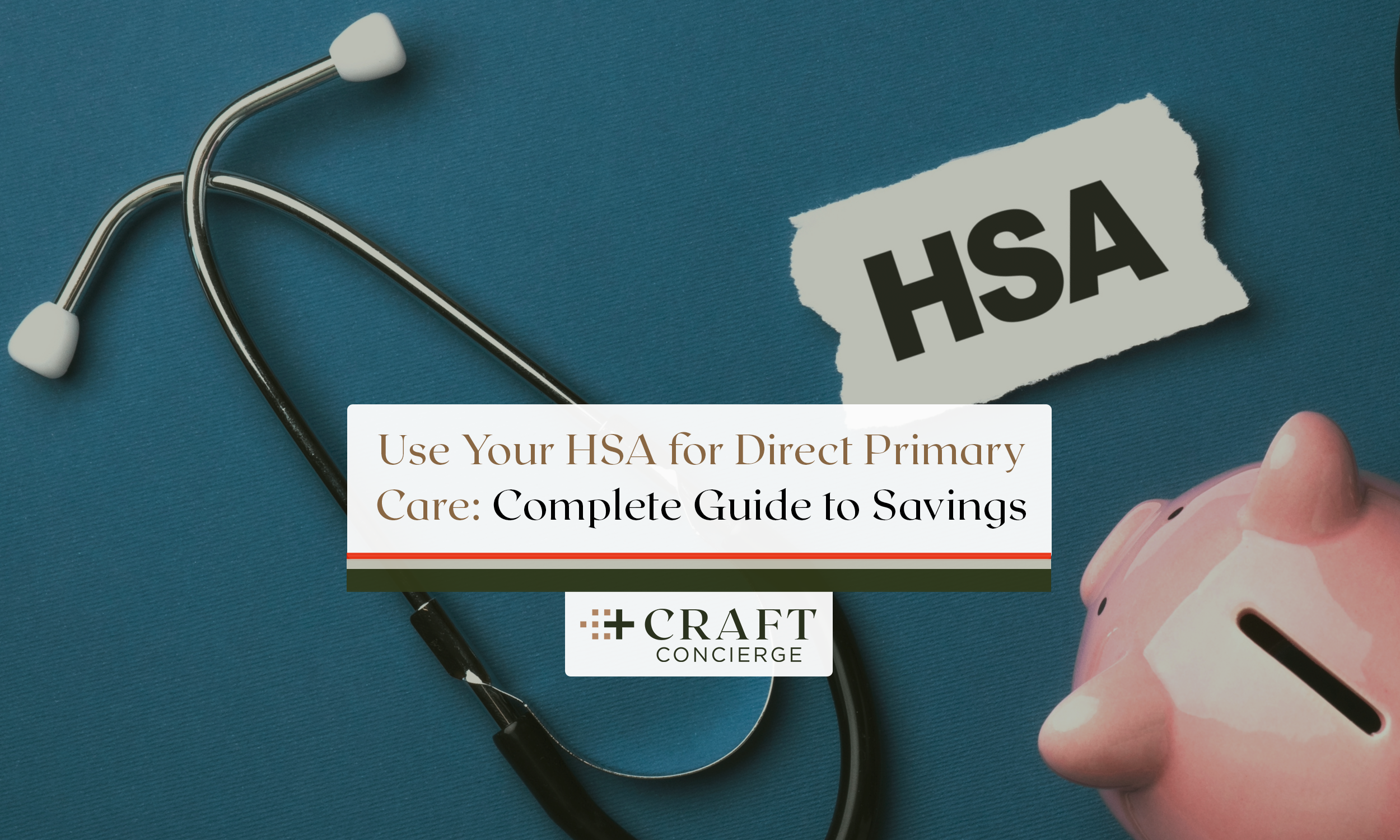You’ve been hearing about Direct Primary Care (DPC) and how it could transform your healthcare experience – but there’s been one nagging question: can you actually use your Health Savings Account (HSA) to pay for it?
Here’s the news that changes everything: yes, you can now use your HSA funds to cover your DPC membership, up to $150 per month. This means you can enjoy comprehensive, unhurried primary care while making the most of your pre-tax healthcare dollars.
Let’s break down exactly how this works, what it means for your wallet, and how to maximize your HSA benefits with Direct Primary Care and additional services like lab work and imaging.
What Makes HSA-Eligible DPC Memberships a Game-Changer

Direct Primary Care has been revolutionizing how people access their primary care physician, but the question of HSA eligibility has held some people back. The ability to use HSA funds for DPC memberships up to $150 monthly removes a significant barrier and opens up new possibilities for managing your healthcare finances strategically.
Think about what this means in practical terms. Instead of paying your DPC membership with after-tax dollars from your checking account, you’re using pre-tax money from your HSA. That’s an immediate savings of 20-30% or more, depending on your tax bracket – without changing anything about the care you receive.
This shift represents more than just tax savings. It’s about making high-quality, relationship-based primary care accessible to more people. When you can use pre-tax dollars for your DPC membership, suddenly that monthly investment becomes significantly more affordable.
The $150 monthly limit covers most DPC memberships comfortably. Many practices charge between $75-150 per month for adult memberships, which means your entire membership could be HSA-eligible. That’s comprehensive primary care – including same-day or next-day appointments, direct communication with your physician, and care coordination – all paid for with tax-advantaged dollars.
Understanding Your HSA: The Basics That Matter
If you’re not already maximizing your Health Savings Account, now’s the time to start. HSAs represent one of the most powerful tax-advantaged savings tools available, offering a triple tax benefit that’s hard to beat.
Here’s how HSAs work their magic. First, contributions go in pre-tax, reducing your taxable income for the year. If you’re in the 24% federal tax bracket and contribute $4,000 to your HSA, that’s $960 in federal tax savings right there – plus additional savings on state taxes and FICA taxes in many cases.
Second, your HSA funds grow tax-free. Unlike a regular savings account where you pay taxes on interest earned, or investment accounts where you pay capital gains taxes, HSA investment growth is completely tax-free. This makes HSAs particularly valuable if you can afford to pay current medical expenses out of pocket and let your HSA grow for future healthcare needs.
Third, withdrawals for qualified medical expenses are tax-free. That means you never pay taxes on that money if you use it for eligible healthcare costs – including your DPC membership, lab work, imaging studies, and countless other medical expenses.
No other savings vehicle offers this triple tax advantage. Even popular retirement accounts like 401(k)s and IRAs only offer tax benefits on the front end or back end – not both.
How Much Can You Actually Save?

Let’s put real numbers to this to see what HSA eligibility means for your budget. Say you’re paying $150 monthly for your DPC membership – that’s $1,800 annually. If you’re in the 24% federal tax bracket, plus a 5% state tax bracket, you’re saving about $522 per year just by using HSA funds instead of after-tax dollars.
Over five years, that’s $2,610 in tax savings. Over a decade? You’re looking at $5,220 saved – and that’s just on your DPC membership alone, not counting other HSA-eligible expenses like lab work and imaging.
The savings multiply when you consider your whole family. If you have a spouse and two children on DPC, with memberships totaling $350 monthly (well within typical family pricing), your annual HSA-eligible DPC expenses reach $4,200. At that same combined 29% tax rate, you’re saving nearly $1,220 annually in taxes.
These aren’t hypothetical savings – this is real money staying in your pocket instead of going to taxes. Money you can use for other priorities, invest for the future, or put toward other healthcare needs.
Beyond DPC: Using Your HSA for Labs and Imaging
The HSA benefits don’t stop at your DPC membership. You can also use HSA funds for laboratory testing and diagnostic imaging – services that DPC practices often coordinate for you at transparent, affordable prices.
Need bloodwork to check your cholesterol or thyroid function? HSA-eligible. Annual comprehensive metabolic panel? HSA-eligible. Vitamin D testing? HSA-eligible.
The same goes for imaging studies. If your DPC physician recommends an X-ray, ultrasound, CT scan, or MRI, you can pay for these services with HSA funds. This is particularly valuable because DPC practices often have relationships with imaging centers and labs that offer cash-pay pricing significantly lower than insurance-negotiated rates.
Here’s where the savings really add up. Let’s say you need a comprehensive annual blood panel that costs $150, and later in the year you need an ultrasound that costs $200. That’s $350 in HSA-eligible medical expenses beyond your DPC membership. In that same 29% combined tax bracket, you’re saving another $101.50 in taxes.
The beauty of this system is its flexibility. Your HSA funds can be used for any qualified medical expense, so you’re not locked into using them in any particular way. Use them for DPC this month, labs next month, and imaging when needed – it’s all eligible and all tax-advantaged.
Maximizing Your HSA Strategy with Direct Primary Care

Now that you understand the basics, let’s talk strategy. How can you maximize these benefits to get the most value from both your HSA and your DPC membership?
First, contribute the maximum allowed to your HSA if possible. For 2025, individuals can contribute up to $4,300, and families can contribute up to $8,550. If you’re 55 or older, you can add an extra $1,000 catch-up contribution. These limits give you substantial room to save for both current and future healthcare expenses.
Second, if you can afford it, consider paying some current medical expenses out of pocket and letting your HSA grow. Your DPC membership, labs, and imaging might be paid from regular checking, while your HSA investments compound tax-free for future needs. You can even save receipts for qualified medical expenses and reimburse yourself years later – there’s no time limit on HSA reimbursements.
Third, think of your HSA as a healthcare retirement account. Medical expenses tend to increase as we age, and having a substantial HSA balance in retirement provides tax-free funds for Medicare premiums, supplemental insurance, long-term care, and out-of-pocket medical costs.
Fourth, if your employer offers HSA contributions as part of your benefits package, make sure you’re taking full advantage. Employer contributions are free money that boosts your healthcare savings without reducing your take-home pay.
How to Actually Use Your HSA for DPC
The practical mechanics of using your HSA for DPC membership are straightforward. Most DPC practices can process HSA debit card payments just like they would any other payment card. Simply use your HSA debit card when paying your monthly membership fee.
If your DPC practice uses automatic monthly billing, you can typically set up your HSA debit card as the payment method. The monthly charge will automatically draw from your HSA, making the process completely hands-free.
Some people prefer to pay with a regular credit card to earn rewards points, then reimburse themselves from their HSA. This works too – just keep documentation of your DPC payments and initiate an HSA withdrawal to reimburse yourself. Make sure you save receipts and documentation in case of an IRS audit, though this is straightforward since DPC membership invoices clearly show the medical nature of the expense.
For lab work and imaging, the process is equally simple. Pay with your HSA debit card at the time of service, or pay with another method and reimburse yourself from your HSA later. The key is maintaining good records of all qualified medical expenses.
Making the Switch: What This Means for Your Healthcare

The ability to use HSA funds for DPC membership represents more than just tax savings – it’s about making proactive, relationship-based healthcare financially accessible. When you combine the clinical benefits of Direct Primary Care with the financial benefits of HSA eligibility, you create a powerful approach to managing your health and your healthcare dollars.
Consider what you’re getting with this combination. Unlimited access to your primary care physician, same-day or next-day appointments, direct communication via phone or text, comprehensive care coordination – all while using tax-advantaged dollars that reduce your overall healthcare costs.
Add in the ability to use HSA funds for labs and imaging, and you have a comprehensive healthcare approach that’s both clinically excellent and financially smart. You’re not sacrificing quality for savings – you’re getting both.
This also simplifies your healthcare finances. Instead of juggling copays, deductibles, and confusing insurance claims for primary care, you have one simple monthly payment from your HSA. For many people, this clarity and predictability is just as valuable as the tax savings.
Your Next Steps: Getting Started with HSA-Funded DPC

You now understand how HSA eligibility transforms the Direct Primary Care value proposition. The question is: what do you do with this information?
First, review your current health insurance situation. To contribute to an HSA, you need to be enrolled in a high-deductible health plan (HDHP). If you’re not currently in an HDHP, your next open enrollment period is an opportunity to make the switch and unlock HSA benefits.
Second, if you already have an HSA, check your current balance and contribution rate. Are you maximizing your contributions? Could you increase them to cover your anticipated DPC membership and other medical expenses?
Third, if you’re interested in Direct Primary Care but haven’t taken the plunge, now is the perfect time. The combination of exceptional primary care and tax-advantaged payment makes this an opportune moment to experience what relationship-based medicine can do for your health.
At Craft Concierge, we’re here to help you navigate this new landscape. Our DPC memberships are designed to provide the comprehensive, unhurried primary care you deserve, and we’re ready to work with your HSA to make it as financially advantageous as possible.
The future of primary care is here – and now it’s more affordable than ever. Let’s talk about how Direct Primary Care and HSA benefits can work together for your health and your financial wellbeing.
Ready to explore how Craft Concierge and your HSA can transform your healthcare experience? Reach out today to learn more about membership options and get started with primary care that puts you first.





